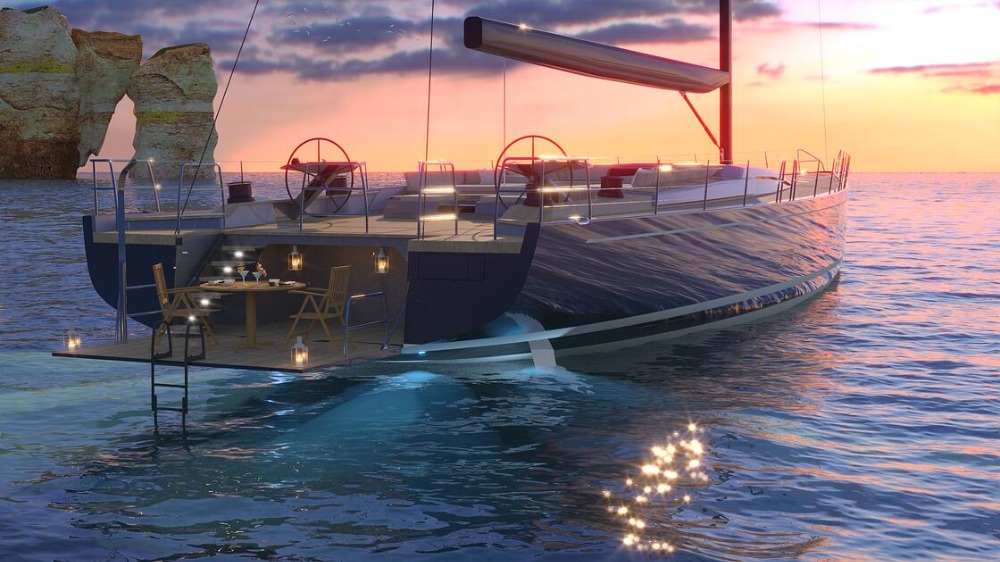Hybrid technology in the 30-40m sailing yacht market
Following an uptick in hybrid models, a look at the challenges associated with the technology in this market segment…
In the same week in May, both Baltic Yachts and Southern Wind made announcements regarding new hybrid sailing yacht models – the Baltic 110 Custom and the SW108 Hybrid. And it’s no coincidence: clients buying in this segment of the market are increasingly interested in diesel-electric hybrid technology for its benefits relating to comfort, fuel efficiency and sustainability.
Upon completion, the Baltic 110 will be the third Baltic superyacht to feature electric propulsion, following the launch of Baltic 142 Canova and Baltic 117 Perseverance. “Not a single client has come to us in the past two years who hasn’t had the concept of hybrid technology or environmentally-considerate solutions very high up on their agenda,” explains Henry Hawkins, executive vice president at Baltic Yachts. “And I think this comes from the sweeping change in outlook about the need for more responsibility and awareness of the footprint you have on the planet.”
For Southern Wind, the SW108 Hybrid is an evolution of other models the shipyard has offered over the years. Yann Dabbadie, technical manager at Southern Wind, says that the development has been driven by the shipyard’s continuous research and development and by client customisation requests. “With IMO Tier III regulations, in some parts of the world it’s now compulsory to have engines on board with less than 130 kilowatts of power, or have to incorporate an SCR to keep emissions down,” he explains. “An SCR on a sailing yacht is not really practical, which brings the diesel-electric option into play.”
“The 100ft range is a tricky size for diesel electric, because you have suppliers of diesel-electric systems like Torqeedo for the small boat market up to about 100 kilowatts... And then you have really heavy equipment developed for the very large ships...”
There are, however, particular challenges when it comes to incorporating hybrid technology on board this segment of the market. “The 100ft range is a tricky size for diesel electric, because you have suppliers of diesel-electric systems like Torqeedo for the small boat market up to about 100 kilowatts, which is not enough for a 108ft yacht. And then you have really heavy equipment developed for the very large ships. We sit somewhere in the middle.”
The main components that make up a hybrid solution include the battery technology, permanent magnet motor generators and the invertors. With no components developed specifically for this market segment currently available, builders have benefitted from other industries driving the development of such components. “For example, if you look at the suppliers we used for the Baltic 117, only about five per cent of the components they make are for the marine sector,” explains Kim Kolam, senior electrical engineer at Baltic Yachts. “The biggest players driving these developments are automotive and mobility.”

Initial drawings of the Baltic 110 Custom
The system used on the SW108 Hybrid has been provided by BAE Systems, and was originally designed for electric vehicles running on a high voltage DC of around 600 volts. “The rest of the equipment, being the propulsion motor and the generator, has also been developed by BAE Systems to be very compact, following their work on something similar for buses,” adds Dabbadie.
Southern Wind made the decision to rely on one supplier for all the components within the SW108 Hybrid package. “Because we are talking about high voltage DC, which is potentially dangerous and advanced technology, we didn't want to start taking different suppliers and assembling their parts,” explains Dabbadie. “With BAE Systems, we have a partner that delivers, and is responsible for, the full hybrid package – from the battery, to the generators, to the propulsion motors, to the regeneration system – and therefore minimise the risk.”
By contrast, to create its optimal hybrid package, Baltic shops around different suppliers for each individual component. And this means a balancing act between pushing boundaries and building a reliable solution. “We are probably less risk averse than others, just by the very nature of the innovative background that Baltic has. But you are walking a fine line because, at the end of the day, the client is coming to us for a high-end product that they can enjoy and rely upon,” says Hawkins.
“So, when we are looking at different components, we have to factor in size, weight, reliability and cost, and then calculate the risk/reward ratio. Because we then have to warrant the boat and make sure everything works. At the moment there’s no off-the-shelf solution, but we’d like to think there will be in the future. And the more boats we build using hybrid technology, the more we learn and the better it gets.”
“We’re not doing the same thing over and over again – I can see fundamental changes on each iteration of hybrid yacht we build...”
For the research and development team at Baltic, another important consideration when developing a hybrid solution is the speed at which the technology being used is changing. “The development is such that, if the Baltic 117 was the perfect solution for us at the beginning of 2020, there would probably be other options if we were to develop the same boat now,” continues Hawkins. “As such, we’re not doing the same thing over and over again – I can see fundamental changes on each iteration of hybrid yacht we build.”
The key is, therefore, to keep abreast of the ongoing developments and solutions available on the market. “Our role is to find companies that are on the edge of development and try and build a collaboration with them,” adds Kolam. “The trick is to find the right people and the right companies.”
Another challenge in terms of the increasing interest in hybrid technology in this market segment is to do with the quality of crew and knowledge base. As Hawkins explains; “We’re stepping away from traditional marine engineering – this sort of voltage needs respect. Yes, the systems are reasonably bullet-proof and you can do a lot of remote diagnostics using modern technology but, in terms of physical maintenance, you need to be skilled in it. So that is a consideration for the end user when they select the product – the crew-shipyard interface is vital.”
While hybrid is a step in the right direction in terms of sustainability, both Southern Wind and Baltic Yachts are looking further into the future and at the possibility of moving away from fossil fuels entirely. “That’s got to be the aim,” concludes Hawkins. “But we would need a partner in it – not just a supplier, but a client that’s willing to take that step with us.”
Main image: Rendering of the SW108 Hybrid
Profile links
NEW: Sign up for SuperyachtNewsweek!
Get the latest weekly news, in-depth reports, intelligence, and strategic insights, delivered directly from The Superyacht Group's editors and market analysts.
Stay at the forefront of the superyacht industry with SuperyachtNewsweek
Click here to become part of The Superyacht Group community, and join us in our mission to make this industry accessible to all, and prosperous for the long-term. We are offering access to the superyacht industry’s most comprehensive and longstanding archive of business-critical information, as well as a comprehensive, real-time superyacht fleet database, for just £10 per month, because we are One Industry with One Mission. Sign up here.
Related news


Bosch plans fuel cell push – will the superyacht industry take note?
Following Bosch's plans to invest €1bn in the technology, Justin Olesinski discusses the significance for yachting
Technology

Lürssen to install first hydrogen fuel cell on a superyacht
The new technology should make it possible to anchor emission-free for 15 days or cruise 1000 nautical miles at a slow speed
Technology
Related news
The carbon trap
4 years ago
NEW: Sign up for
SuperyachtNewsweek!
Get the latest weekly news, in-depth reports, intelligence, and strategic insights, delivered directly from The Superyacht Group's editors and market analysts.
Stay at the forefront of the superyacht industry with SuperyachtNewsweek




